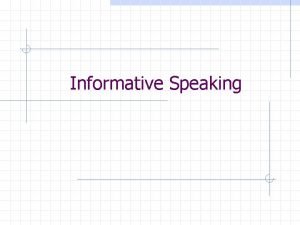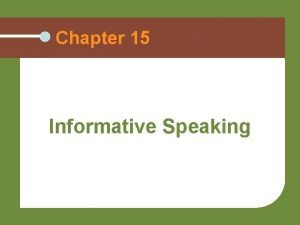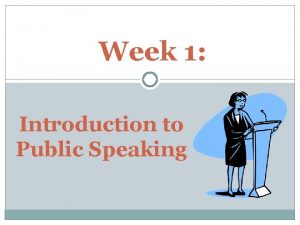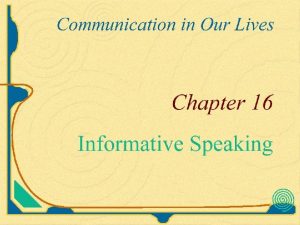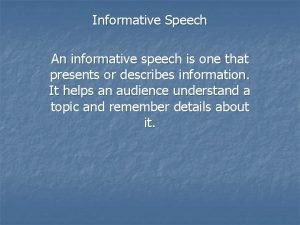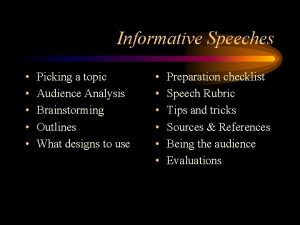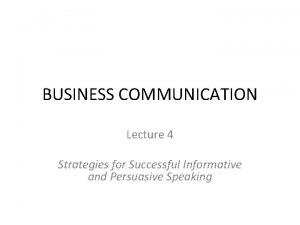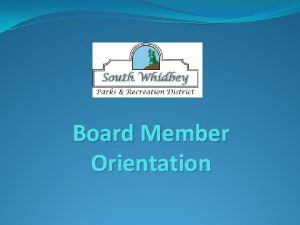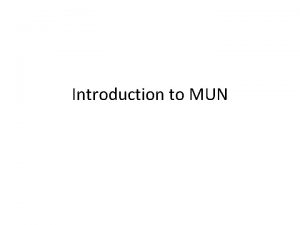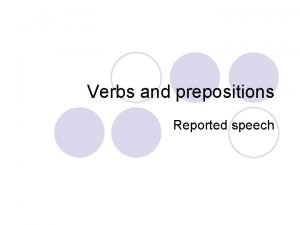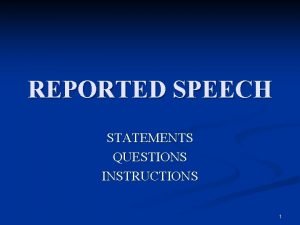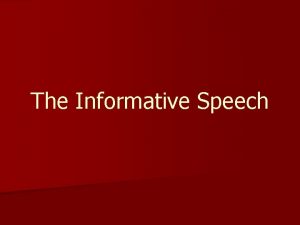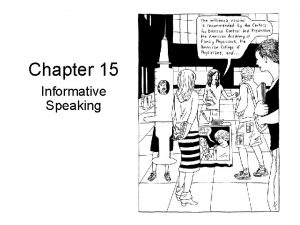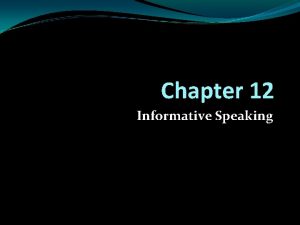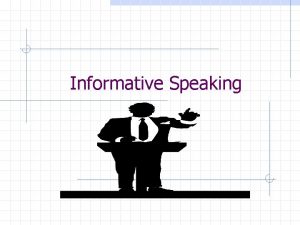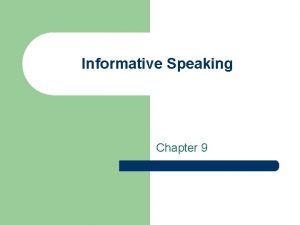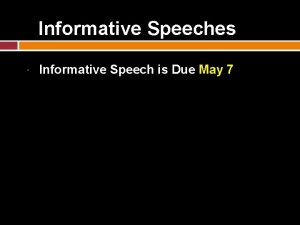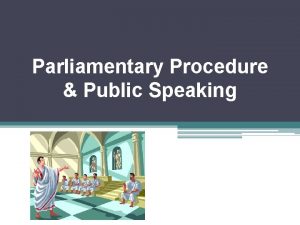Informative Speech Informative speaking Introduction An informative speech





































- Slides: 37

Informative Speech 常姗姗 上海财经大学

Informative speaking: Introduction • An informative speech: – shares information or ideas with audience – increases understanding and awareness of a topic • Try to give listeners new knowledge • Keep information audience-centered

Informative speaking: An overview • In this chapter, we will discuss: – Techniques for informing – Types of informative speeches – Developing your informative speech – Clarifying and simplifying your message

Techniques for informing: Definition • You explain the essence, meaning, or purpose of something such as: – an object – a person or group – an event – a process – an idea or concept

Techniques for informing: Definition

Techniques for informing: Explanation • Provide analysis of something to clarify it, or you trace a line of causal connections between events. • Explanation works well on speeches that: – present a process – trace the emergence of an event – illustrate how something works

Techniques for informing: Description • Use words to paint a mental picture. • Maximum impact with: – vivid language – audiovisual aids – details that evoke audience’s senses

Techniques for informing: Demonstration • Goal is to teach how a process or a set of guidelines works. • Use physical modeling and verbal elements to lead audience through process. • Demonstration requires confidence and practice. • Demonstrating and repeating is useful to help audiences retain information.

Techniques for informing: Demonstration

Techniques for informing: Narrative • Present a story that entertains while it informs. • Base narratives on audience analysis and support your message.

Tips for techniques of informing • Tip: Stories can humanize speakers and improve their credibility, but, as a speaker, you must practice the stories to sound natural and unrehearsed. • Tip: Be audience-centered—it is your job to get information across to the audience, so make this as easy as possible for them by choosing a technique that is appropriate for them and the topic.

Types of informative speeches: Objects-inhuman objects • Types of objects include: – – Mechanical/technological Natural Cultural Personal objects • Appropriate techniques: – – Definition Explanation Demonstration Narrative

Topics • Computers • Sichuan masks • Su embroidery • Panda • Acupuncture

Types of informative speeches: Individuals or groups • People are fascinated by others. • Ideas for people include: – Famous politician – Famous sports star, entertainer, or artist – An unsung hero – A tragic figure

Types of informative speeches: Events • Notable or exceptional occurrences from the present or past.

Topics like • Insomnia • Marriage • World Cup/ NBA • Tsunami • Cyber crime

Types of informative speeches: Processes • A series of steps or stages that lead to outcomes • Informative speeches about processes can be at the micro or macro level. • Walk the audience through the steps and their sequence.

Topics like • How typhoons develop • How to write an effective job resume • How to perform Tai Chi

Types of informative speeches: Ideas • A theory, principle, belief, or value – Ideas are relatively abstract – Ideas benefit from “real life” analogies – Ideas need to connect with the audience’s: • interests • level of education • prior exposure to the idea

Topics like • Theories of evolution • Philosophies of education • Military theory • Arguments for and against Olympic Math

Developing your informative speech • Consider characteristics of the speaking situation. • For class presentations note the requirements for: – topic – content – format

Developing your informative speech • For outside speeches, note: – the occasion – forum – time of presentation – expected length of presentation – audience size

Developing your informative speech: Analyzing your audience • Examine audience demographics: – – – – – Age Ethnicity Gender Religion Sexual orientation Academic major Educational background Political affiliation Occupation

Developing your informative speech: Analyzing your audience • Look for a common ground, such as shared values and interests.

Developing your informative speech: Selecting a technique • Choice of technique helps decide how to develop main points and supporting materials. – For demonstration, consider forum and audience size. – For explanation or description, focus on demographics. – For narrative, look to common ground issues.

Clarifying and simplifying your message: Clarity • Being clear makes it easier for audience to understand.

Clarifying and simplifying your message: Simplify • Keep the information simple to help your audience understand.

Clarifying and simplifying your message: Move from general to specific • Ask yourself: – What message do you want your audience to take away? • Answer can help you narrow down your topic

Clarifying and simplifying your message: Less is more • Reduce the quantity of information you present.

Clarifying and simplifying your message: Make the complex familiar • Use definitions and analogies. • Avoid jargon and an overabundance of technical terminology.

Clarifying and simplifying your message: Use audiovisual aids • Use audiovisual aids to clarify and simplify your message.

Clarifying and simplifying your message: Reiterate (重申) • Refer to your message multiple times, with different words each time.

Clarifying and simplifying your message: Repeat • Use the same words each time.

Tips for Informative Speech • Don’t overestimate what the audience knows • Don’t be too technical • Avoid abstraction • Be creative • Personalize your ideas

Tips for Informative Speech e. g. I would like to inform you about the causes, symptoms, and treatment of asthma. You may have never suffered from asthma, nor have friends and loved ones, but if you were aware that German composer Beethoven, American actress Elizabeth Taylor, and Chinese writer Lu Xun are all known to have been plagued with the disease, you might wish to know a little more about it.

Tips for informative speeches • Tip: Be audience-centered, choose a topic that will be new to your audience. Novelty will help get and keep their attention. • Tip: To aid in clarity and interest, really focus on what you hope the audience will know at the end of the speech. The more you narrow this focus, the easier it will be to construct an interesting, informative speech.

Class Activity • • • How to make Chinese dumplings( process) A tourist spot in or near Shanghai (object) Theories of interpretation ( concept) A traditional Chinese holiday ( event) How to sell used personal items online ( process) • The mascot for World Expo 2010 Shanghai (object) • A high school reunion ( event) • Principles of legalism ( concept)
 Informative vs persuasive writing
Informative vs persuasive writing Persuasive vs informative speech
Persuasive vs informative speech Uil informative speaking
Uil informative speaking Characteristics of effective informative speaking
Characteristics of effective informative speaking Goals of informative speaking
Goals of informative speaking What is the essence of informative speaking
What is the essence of informative speaking The art of public speaking chapter 1 review questions
The art of public speaking chapter 1 review questions How to close an argumentative essay
How to close an argumentative essay Informative vs persuasive
Informative vs persuasive Includes anything visible and tangible in form
Includes anything visible and tangible in form Specific purpose statement for an informative speech
Specific purpose statement for an informative speech Possible speech topics
Possible speech topics Informative speech strategies
Informative speech strategies Speech therapy tattoos
Speech therapy tattoos Audience analysis for informative speech
Audience analysis for informative speech Informative or expository speech
Informative or expository speech Informative communication strategies
Informative communication strategies Persuasive and informative speech
Persuasive and informative speech Informative speech characteristics
Informative speech characteristics Informative speech about phobias
Informative speech about phobias Informative speech
Informative speech Body paragraph structure
Body paragraph structure Band introduction speech
Band introduction speech Speech conclusion example
Speech conclusion example Good morning to everyone
Good morning to everyone Good afternoon class
Good afternoon class Speech analysis introduction example
Speech analysis introduction example New board member introduction speech
New board member introduction speech Mun dress code
Mun dress code Award presentation speech
Award presentation speech Self introduction speech attention getters
Self introduction speech attention getters Faculty introduction speech
Faculty introduction speech Whats an opinion essay
Whats an opinion essay Conclusion meaning and example
Conclusion meaning and example Match the verbs and prepositions from
Match the verbs and prepositions from Pure speech vs symbolic speech
Pure speech vs symbolic speech Speech to the young: speech to the progress-toward
Speech to the young: speech to the progress-toward Ann says i'm tired
Ann says i'm tired
